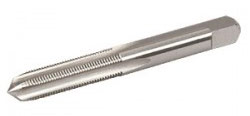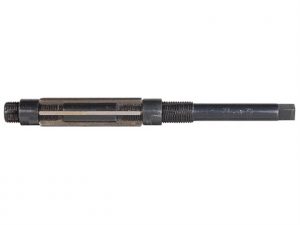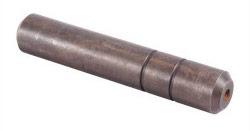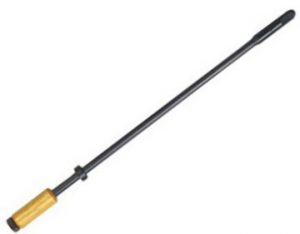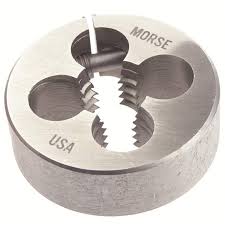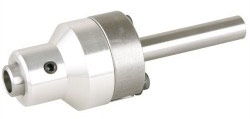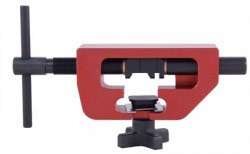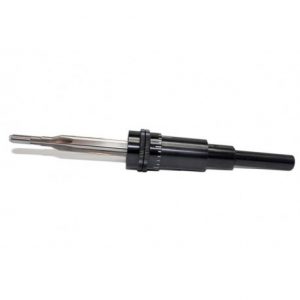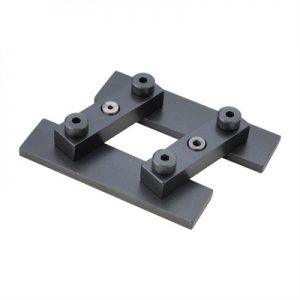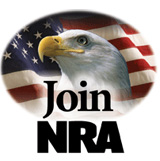Tools
Showing all 56 results
-
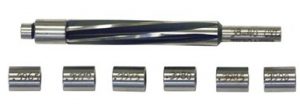
.32 Cal. Throating Cutter
$40.00Uniforms the chamber throats in the cylinder of a revolver for best accuracy.
Includes 7 pilots, cuts 32 caliber cylinders.
NOTE: No gauges are available for shipment with this reamer.
-

.38/.357 Special Throating Cutter
$40.00Uniforms the chamber throats in the cylinder of a revolver for best accuracy.
Includes 7 pilots, cuts .358
NOTE: No gauges are available for shipment with this reamer.
-
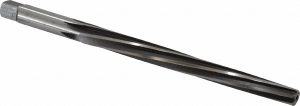
#6 Hinge Pin Reamer
$20.00includes 1 hinge pin with rental
-
Sale!
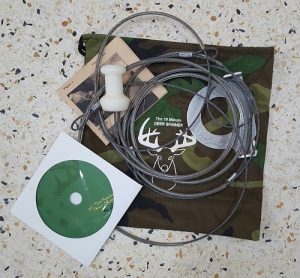
10 Minute Deer Skinner
Original price was: $28.99.$22.95Current price is: $22.95.How many times have you said, “Now that the animal is down, The fun stops and the work starts.”
Not so with this handy tool.
• Absolutely the fastest and easiest way to skin a deer • Keeps meat clean from hair and other contaminants • Professional method of skinning, minimal cutting and reduces nicks in hide • Uses the power of your vehicle to quickly and efficiently remove deer skin The 10 Minute Deer Skinner is the most time efficient method that we’ve found (using the least amount of physical effort) to take a deer from the buck pole to the deep freeze. Simply field dress your deer and placed on a clean sheet of plastic before the 10 Minute Deer Skinner is utilized.
STEP 1: Extend the skin cut on the deer from the field dressed cut to the base of head. (Two to four inches from the head.) From the end of this cut, make a complete circle around the neck, connecting with the original cut. Important: Cut skin only, not the meat.
STEP 2: Attach loop of plain cable to an immovable object (tree, stump, ball hitch of parked vehicle, etc.). Slip the loop on the other end of plain cable around the deer head, behind the ears, and hand tighten. From cut on back of neck, pull hide back toward the tail six (6) to ten (10) inches.
STEP 3: Cut skin on each front leg from knee joint to brisket cut. Make a cut circling the knee joint. Note: DO NOT PULL SKIN. Again, cut skin only, not meat. Brush hair off drop cloth, and clean area around the deer, so the skinned carcass will drop on a clean surface.
STEP 4: This step will utilize the two stage ball and skinner plate for hide removal. Take the long cable that contains the skinner plate and two stage ball and place the skinner plate (flat surface down) on the raw side of the hide. Push the small end of the two stage ball from the hair side of the hide, through the hole in the skinner plate. Hand tighten cable around the narrow section of the two stage ball by pulling only on the coated end of the cable.
STEP 5: Advance vehicle (slowly) to remove slack. Hunter should stand to the side of deer for safety reasons and to signal the driver. Vehicle should be advanced (see Figure 4) until skin is removed to the hind leg joints. Cut skin around each back leg between knee and ankle joint. Resume truck advancement (if necessary) until skin is completely removed. Your deer should be completely skinned and dropped back on a clean, plastic surface.
Note: If the animal has been down for an extended period of time, the front legs of the deer may need to be moved toward rear to permit clean skin removal around the legs. Also, if the hide is to be kept, skin tail by hand (as shown in video). Finally, if the hide is to be tanned, split each back leg open from hind quarter to end of leg.
Kit includes: Both Cables with the skinner system fully assembled and ready to use. Written instructions, a DVD with an instructional video on how to use the 10 Minute Deer Skinner and a pouch the carry it all in. Make Skinning Fun!
-
Sale!

10 Minute Deer Skinner x 2 and get a free knife
Original price was: $69.90.$37.95Current price is: $37.95.Buy 2, 10 Minute Deer Skinners and get this knife Free!
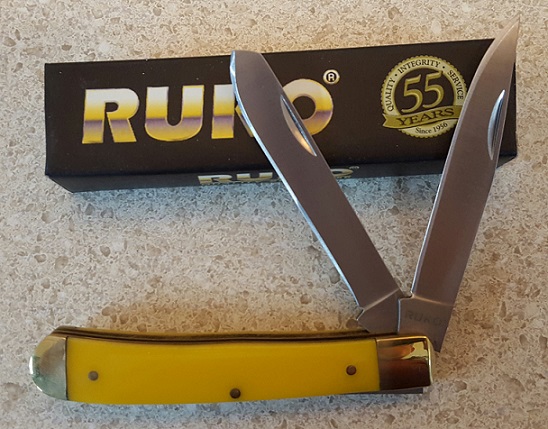
• Absolutely the fastest and easiest way to skin a deer • Keeps meat clean from hair and other contaminants • Professional method of skinning, minimal cutting and reduces nicks in hide • Uses the power of your vehicle to quickly and efficiently remove deer skin The 10 Minute Deer Skinner is the most time efficient method that we’ve found (using the least amount of physical effort) to take a deer from the buck pole to the deep freeze. Simply field dress your deer and placed on a clean sheet of plastic before the 10 Minute Deer Skinner is utilized.
STEP 1: Extend the skin cut on the deer from the field dressed cut to the base of head. (Two to four inches from the head.) From the end of this cut, make a complete circle around the neck, connecting with the original cut. Important: Cut skin only, not the meat.
STEP 2: Attach loop of plain cable to an immovable object (tree, stump, ball hitch of parked vehicle, etc.). Slip the loop on the other end of plain cable around the deer head, behind the ears, and hand tighten. From cut on back of neck, pull hide back toward the tail six (6) to ten (10) inches.
STEP 3: Cut skin on each front leg from knee joint to brisket cut. Make a cut circling the knee joint. Note: DO NOT PULL SKIN. Again, cut skin only, not meat. Brush hair off drop cloth, and clean area around the deer, so the skinned carcass will drop on a clean surface.
STEP 4: This step will utilize the two stage ball and skinner plate for hide removal. Take the long cable that contains the skinner plate and two stage ball and place the skinner plate (flat surface down) on the raw side of the hide. Push the small end of the two stage ball from the hair side of the hide, through the hole in the skinner plate. Hand tighten cable around the narrow section of the two stage ball by pulling only on the coated end of the cable.
STEP 5: Advance vehicle (slowly) to remove slack. Hunter should stand to the side of deer for safety reasons and to signal the driver. Vehicle should be advanced (see Figure 4) until skin is removed to the hind leg joints. Cut skin around each back leg between knee and ankle joint. Resume truck advancement (if necessary) until skin is completely removed. Your deer should be completely skinned and dropped back on a clean, plastic surface.
Note: If the animal has been down for an extended period of time, the front legs of the deer may need to be moved toward rear to permit clean skin removal around the legs. Also, if the hide is to be kept, skin tail by hand (as shown in video). Finally, if the hide is to be tanned, split each back leg open from hind quarter to end of leg.
Kit includes: Both Cables with the skinner system fully assembled and ready to use. Written instructions, a DVD with an instructional video on how to use the 10 Minute Deer Skinner and a pouch the carry it all in. Make Skinning Fun!
-
Sale!

10 Minute Deer Skinner x 2 and get a free skinning knife
Original price was: $69.95.$39.50Current price is: $39.50.Buy 2, 10 Minute Deer Skinners and get this knife Free!
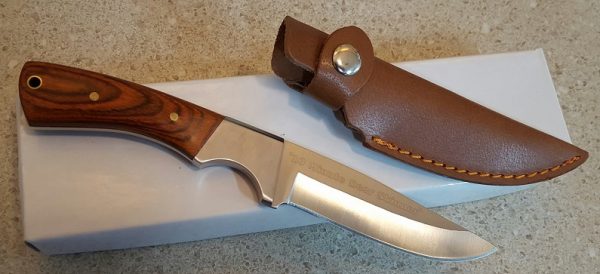
• Absolutely the fastest and easiest way to skin a deer • Keeps meat clean from hair and other contaminants • Professional method of skinning, minimal cutting and reduces nicks in hide • Uses the power of your vehicle to quickly and efficiently remove deer skin The 10 Minute Deer Skinner is the most time efficient method that we’ve found (using the least amount of physical effort) to take a deer from the buck pole to the deep freeze. Simply field dress your deer and placed on a clean sheet of plastic before the 10 Minute Deer Skinner is utilized.
STEP 1: Extend the skin cut on the deer from the field dressed cut to the base of head. (Two to four inches from the head.) From the end of this cut, make a complete circle around the neck, connecting with the original cut. Important: Cut skin only, not the meat.
STEP 2: Attach loop of plain cable to an immovable object (tree, stump, ball hitch of parked vehicle, etc.). Slip the loop on the other end of plain cable around the deer head, behind the ears, and hand tighten. From cut on back of neck, pull hide back toward the tail six (6) to ten (10) inches.
STEP 3: Cut skin on each front leg from knee joint to brisket cut. Make a cut circling the knee joint. Note: DO NOT PULL SKIN. Again, cut skin only, not meat. Brush hair off drop cloth, and clean area around the deer, so the skinned carcass will drop on a clean surface.
STEP 4: This step will utilize the two stage ball and skinner plate for hide removal. Take the long cable that contains the skinner plate and two stage ball and place the skinner plate (flat surface down) on the raw side of the hide. Push the small end of the two stage ball from the hair side of the hide, through the hole in the skinner plate. Hand tighten cable around the narrow section of the two stage ball by pulling only on the coated end of the cable.
STEP 5: Advance vehicle (slowly) to remove slack. Hunter should stand to the side of deer for safety reasons and to signal the driver. Vehicle should be advanced (see Figure 4) until skin is removed to the hind leg joints. Cut skin around each back leg between knee and ankle joint. Resume truck advancement (if necessary) until skin is completely removed. Your deer should be completely skinned and dropped back on a clean, plastic surface.
Note: If the animal has been down for an extended period of time, the front legs of the deer may need to be moved toward rear to permit clean skin removal around the legs. Also, if the hide is to be kept, skin tail by hand (as shown in video). Finally, if the hide is to be tanned, split each back leg open from hind quarter to end of leg.
Kit includes: Both Cables with the skinner system fully assembled and ready to use. Written instructions, a DVD with an instructional video on how to use the 10 Minute Deer Skinner and a pouch the carry it all in. Make Skinning Fun!
-
Sale!

25-06 Niedner
$8.00Also known as the 25 Niedner
-
Sale!
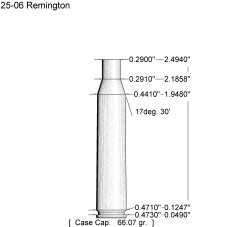
25/06 Remington
$49.00 -
Sale!
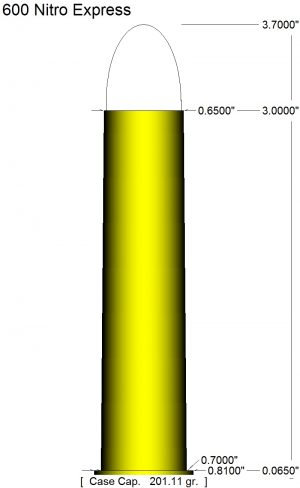
600 Nitro Express
$16.00 -
Sale!

6mm Dasher Norma
$49.00Pilot Floating (For Norma Brass)
-
Sale!
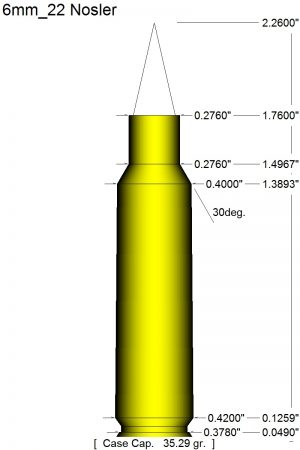
6mm/22 Nosler
$49.00Pilot Floating
NOT 24 Nosler
-
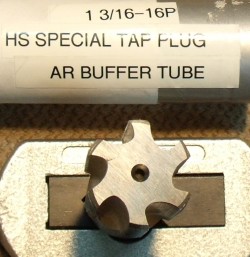
AR-15 Buffer Tube Tap (Rental)
$20.00Steel Tap is used to chase or re-thread the mounting threads for AR-15 buffer tubes.
1 3/16 – 16 TPI
NO AVAILABLE TAP HANDLE
-
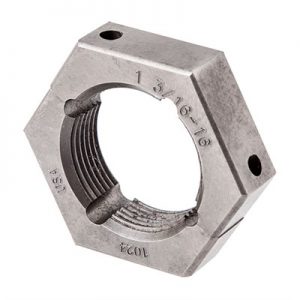
AR-15 Muzzle Thread Chase Die (1/2″x28)
$15.00Steel Die is used to chase or re-thread the mounting threads on AR-15 Flash Hider.
1/2″x28
-
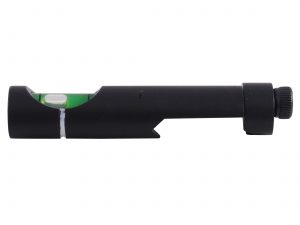
Bubble Level, SME (Weaver Dovetail)
$15.95The SME Bubble Bore level allows the shooter to check both the rifle bore and the reticle alignment at a glance. Constructed of aircraft grade aluminum.
Specification: SME Bubble Bore Level
Material: Aluminum
Notes:
- Attaches to any Weaver-style rail or base.
- Ambidextrous Mounting
- Assures bore alignment at a glance.
- White line on housing for quick reference.
- Hex wrench for mounting included
-
Sale!
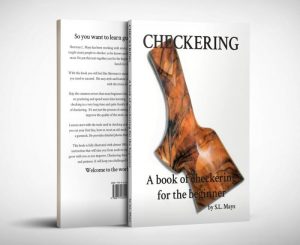
Checkering, A book of checkering for the beginner
Original price was: $48.95.$46.85Current price is: $46.85.Paperback, 8.5×11
176 pages.
Sherman L. Mays assembled this how to manual from his considerable experience checking for a living. He has taught many others to checker and for this reason his book is excellent at showing the novice how to get started and the mistakes to avoid. His easy going and often humorous style makes this a pleasant read and the prolific use of photos aid in your understanding of the subject.
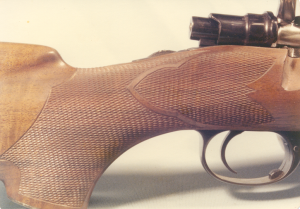
Mays shows many patterns and details in his book on checkering.
If you have ever wanted to learn how to checker this book is ideal for building skills and saves you a lot of time learning your way around the difficulties every student of checkering faces. Instead of working all by yourself, invite Sherman, via this book to come into your shop to stay. Handbooks are at their best when they become a well loved reference book, I think this book will be just that.
There are nearly 300 pictures used to show you the details that matter.
Mays starts with teaching you how to cut that first line and then increased the difficulty of each project like any good instructor would. Even a reluctant student would have no reason to avoid cutting their first line of checking in a few short hours after acquiring this text.
Free shipping on this Book.
-
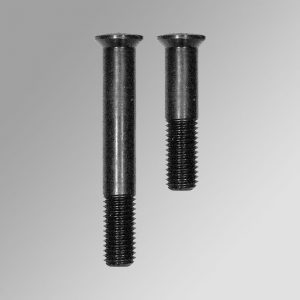
Forster – Trigger Guard Screw Sets
$7.49These simple tools allow you to keep the barreled action properly aligned in the stock during the inletting process. Without them it is very difficult to get a tight inlet.
- 98 Mauser
- Springfield 03, 03-A3 and Krag actions
- Remington 700, 721, 722
- Savage 110
- Winchester 70
- Sako
-
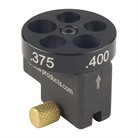
Forster Datum Dial
$89.95The Forster Datum Dial makes it possible for the handloader or gunsmith to use ordinary dial calipers to make normally difficult length measurements based on the case shoulder. By measuring cases to the datum line on the shoulder, the reloader can custom-fit the ammunition to a rifle’s chamber for the best possible fit for better accuracy potential and longer case life.
Gunsmiths can easily check the length of customers reloads verses the chamber.
This tool can also be used to double check headspace gauges if questions arise
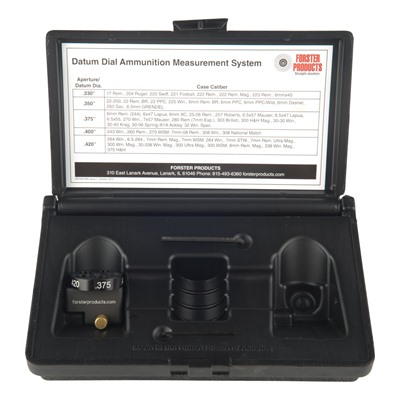
Datum Dial in box, from Forster
Included are complete instructions, storage box, and a laminated chart with common datum diameters.
-
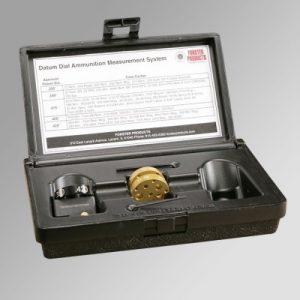
Forster Datum Dial Kit
$132.95The Forster Datum Dial Kit makes it possible for the handloader or gunsmith to use ordinary dial calipers to make normally difficult length measurements based on the case shoulder. By measuring cases to the datum line on the shoulder, the reloader can custom-fit the ammunition to a rifle’s chamber for the best possible fit for better accuracy potential and longer case life.
The gold “bullet dials” makes it easy to accurately determine bullet seating depth measured from the ogive when changing the seater die setting or when checking loaded rounds for consistency. It can also be used to check the bullets alone for variations that could hurt accuracy.
The Complete Kit includes the Body with Case Dial for checking cases and two Bullet/Cartridge Dials. The #1 dial fits 224, 243, 264, 284, and 308 calibers. The #2 dial fits 172, 204, 257, 277, and 338.
Gunsmiths can easily check the length of customers reloads verses the chamber. Seating depth verses throat, and uniformity of ammunition. All errors that can make problems hard to diagnose.
This kit can also be used to double check headspace gauges if questions arise.
Included are complete instructions, storage box, and a laminated chart with common datum diameters.
-
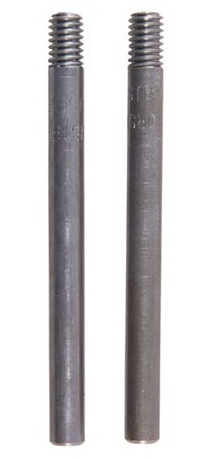
Forster Inletting Guide Screws (Stock Making)
$8.95These simple tools allow you to keep the barreled action properly aligned in the stock during the inletting process. Without them it is very difficult to get a tight inlet.
- 98 Mauser
- Springfield 03, 03-A3 and Krag actions
- Enfield 1914, 1917 and SMLE
- CZ 550 or 7.7 Jap Arisaka
- Remington 700, 721, 722
- Winchester 70 or 54
- Sako
-
Sale!
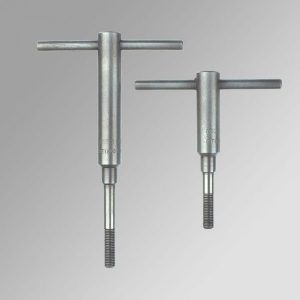
Forster Stock Makers Hand Screws (Stock Making)
$19.95These simple tools allow you to keep the barreled action properly aligned in the stock during final fitting.
Recommended by stockmakers, these Forster Stockmakers Hand Screws are used in the final accurate fitting of the stock to the action. These screws are precision made and hardened to make repeated trial fittings. Set of two.
To save time and to avoid damaged guard screws or a ruined stock, don’t attempt to inlet a stock without the proper stockmakers hand screws.
- 98 Mauser
- Remington 700, 721, 722
- Winchester 70 or 54
- Enfield P-14 or P-17
- Springfield or Krag
- Sako: Except, Model 75
- Ruger 77
- 7.7 Jap Arisaka
- 6.5 Jap
-
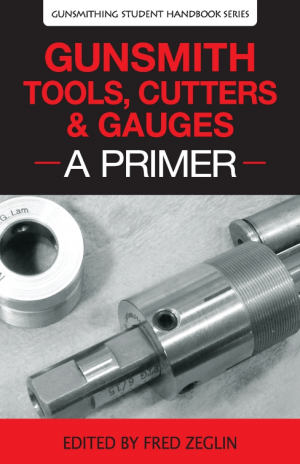
Gunsmith Tools, Cutters & Gauges – A Primer
$12.95Shipping Now!
We spoke with leaders in the tool making industry about the things they spend most of their time and effort educating clients about. Contributions from Clymer, Forster, Manson, JGS, PTG, SAAMI and more are all included. There are books for machinists that teach this type of information, but until now there has never been a book for gunsmiths that explains the tools of the trade and how they should be utilized. The idea is simple, answer your questions before you order any tool.
Nomenclature is important, when you talk to a reamer maker, gunsmith or client you want to know the correct terms. This indicates to those you work with that you took the time the understand the tools. It will improve your ability the sell work to customers, buy or rent the right tools for the job. You will save untold hours and dollars, don’t learning at the “School of Hard Knocks”.
When you understand tools, they work better and last much longer. This both saves money and increases profits.
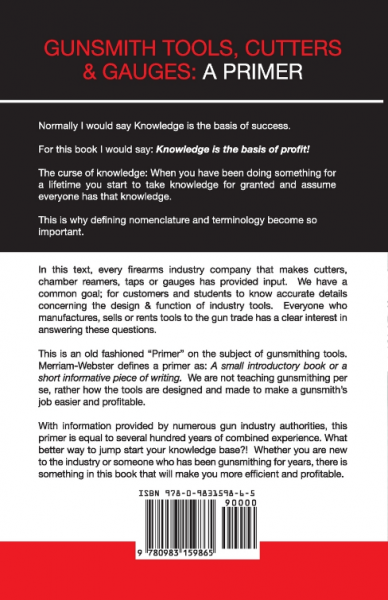
What is discussed?
All types or reamers specific to firearms work
Reamer Holders
Reamer Stops
Use of Reamers
Cutting Lube
Chip Welding and how to Stop it.
Misconceptions About Reamers
Chatter and its Cures
Shotgun Chamber Tools
Forcing Cone Reamers
Shotgun Chokes
Screw Choke Tooling
Measuring for Choke Tubes
Choke Lube
Defining Headspace
Choosing the Correct Gauge
Improved Chambers and Headspace
Headspace Gauge Interchange Chart
Charts for Tooling and bushings.
EBOOK NOW AVAILABLE TOO.
-

Muzzle Thread Chase Die (5/8″x24)
$15.00Steel Die is used to chase or re-thread the mounting threads on muzzle brakes or suppressors.
5/8″x24
-
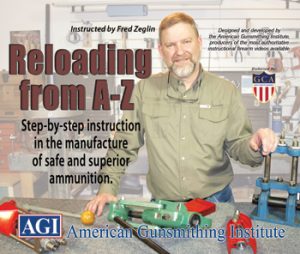
Reloading From A to Z, DVD (AGI Reloading/Gunsmithing Instruction)
$289.95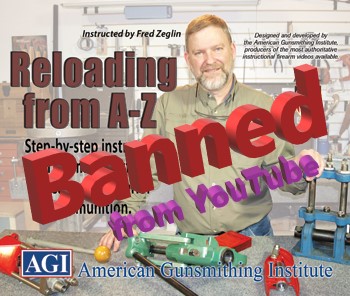
Reloading from A-Z is a course with nearly 8 hours of information in video format you can watch as often as you like to brush up or pick up a new skill.
The Liberals at YouTube don’t want you to see this.
Learn how-to make hand loaded ammunition tailored specifically for YOUR needs. This course is far more in depth than any other reloading course on the market. Renowned cartridge designer, gunsmith, and AGI instructor Fred Zeglin begins this course by addressing reloading from its most basic fundamentals. This allows the new reloader to begin the process almost immediately with confidence and safety. He goes further and introduces you to tools that increase the speed and quality of the reloading process.
Popular tools offered by numerous manufacturers of reloading gear are demonstrated and explained. He also covers casting bullet techniques and advanced precision reloading for long range shooting.
Most people learn reloading strictly from a mechanical ‘monkey see, monkey do’ view point. In other words, nobody ever completely explains to them WHY operations are performed a certain way or WHAT value they have. In this course Fred shows you, from a gunsmiths perspective, what is happening to the brass when fired and when it goes through the reloading process. This information will make you a well informed reloader and if you’re a gunsmith, will help aid in diagnosing problems with your clients’ reloads and guns.
Accuracy is always the name of the game for any shooter. Fred talks about what makes a safe, accurate reload and shares simple tricks that will save you hours of trial and error at the reloading bench and range. Obviously, this translates into saving money on components as well.
Our Special price here is for the course without the Certification from AGI. If you prefer to acquire the Certification we can arrange that or you can buy direct from AGI.
We are often asked, “Why So Much?” Well its nearly 8 hours of intensive instruction, in a friendly conversational style that makes it all easy to understand.
As a bonus Darrel Holland’s “Advanced Reloading Techniques” is included in the package.
-
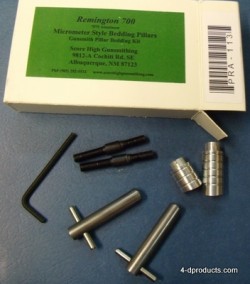
Remington 700 Pillar Bedding Gunsmith Kit
$49.95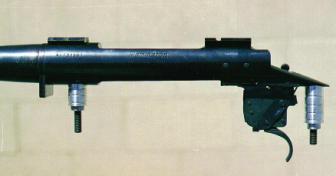 Remington 700 Gunsmith’s pillar bedding kit comes with a set of adjustable pillars and installation tools for a perfect job every time. Full instructions included. refill pillar kits available separately. Just add your favorite bedding compound.
Remington 700 Gunsmith’s pillar bedding kit comes with a set of adjustable pillars and installation tools for a perfect job every time. Full instructions included. refill pillar kits available separately. Just add your favorite bedding compound. -

Rental Protection Plan
$75.00Seems like a lot of money… Why should I do this?
For a short description click here.
Rental Protection Plan (RPP) units as described below, once purchased, remain in effect for all future orders until protection plan units are utilized for damages on an invoice. So this plan clearly benefits repeat customers the most. Rental Protection Plan is optional, if not purchased all standard rental terms apply to every order.
If customer participates in the Rental Protection Plan, Lessee/Customer will be charged a Rental Protection Plan fee. The Rental Protection Plan fee is $75 per unit for up to $300 (average value of one reamer and set of gauges) in repair or replacement costs. More than one unit of Rental Protection may be purchase if you intend to rent multiple tools. Only full units are offered, each unit is the same cost and value.
4D Reamer Rentals LTD is the final arbiter of tool condition and therefore when the Rental Protection Plan units are utilized to pay for replacement or repair of Tool(s). Once utilized the plan units are of no further value and new Rental Protection Plan units would need to be purchased to protect lessee’s future rentals. Protection per unit is up to $300 in loss but no partial use is permitted once applied to an invoice the unit is expired and of no value.
Under the standard rental agreement the lessee is responsible for the rental fees and up to the full amount of the deposit value for any lost or damaged tool(s). Lessee by purchasing RPP units is greatly reducing the potential cost for lost or damaged tools. Rental Protection Plan fees are non refundable.
Lessee/Customer understands and agrees that the Rental Protection Plan is NOT insurance. In exchange for the Rental Protection Plan fee, 4D Reamer Rentals LTD agrees to reduce the Lessee/ Customer’s exposure for loss and damage to rented Tool(s)/Item(s) on the contract/invoice in certain situations, as detailed below:
RENTAL PROTECTION: Rental Protection Plan is optional.
By Lessee/Customer accepting RENTAL PROTECTION Plan and paying the additional charge set forth, subject to the exceptions listed below Lessee shall be entitled to the following protection:
- Tools will be re-sharpened or replaced at no charge up to the limit of the Rental Protection Plan units purchased, when necessary. Deposit values listed on the price list and web site are the dollar amount that will be applied to damaged or broken tools when the RPP is utilized.
- All small parts, such as c-clips, screws and bushings are covered for damage or loss.
- Lessee shall not be responsible for ongoing rental expenses for the lost or damaged item(s)/tool(s) while they are out of service.
- If tools are lost in shipping and the carrier cannot locate them and/or the insurance carrier on the package refuses to pay, you are protected.
EXCEPTIONS: Notwithstanding the foregoing, Lessee shall remain fully liable for all loss and/or damage to Tools resulting from:
-
- Loss or damage resulting from overloading or abusing the Tools.
- Loss or damage resulting from lack of lubrication or other normal treatment of tools.
- Loss due to theft or mysterious disappearance, in short you must still support tracking and location efforts if tools disappear.
- Loss in return shipping if you do not insure your return packages, you will need a receipt and tracking info.
- Loss or damage caused by negligence or infidelity of Lessee, his employees, or persons with whom the Tools are entrusted.
- Use of Tools in violation of any of the Rental Terms, or any manner inconsistent with the manufacturer’s instructions, including but not limited to neglect, misuse, wrong application, or abuse of the Tools.
- No modification of any kind are permitted on our tools! EVER!
- Use or operation of the Tool(s) in violation of any law, regulation or ordinanace.
The RENTAL PROTECTION PLAN IS NOT INSURANCE. RENTAL PROTECTION does not provide liability or property damage coverage or any type of insurance coverage. Lessee remains responsible for all personal injuries or property damage related to operation/use of the Tools. If Lessee has insurance covering such loss or damage, Lessee shall exercise all rights available to him/her under said insurance, take all action necessary to process said claim, and Lessee further agrees to assign said claim and any and all proceed from such insurance to Lessor where the Lessor has experienced the loss. Upon request of Lessor, Lessee shall furnish name of insurance agent, insurance company, and complete information concerning insurance coverage carried. Rental Protection Plan is optional, if not purchased all standard rental terms apply to every order.
-
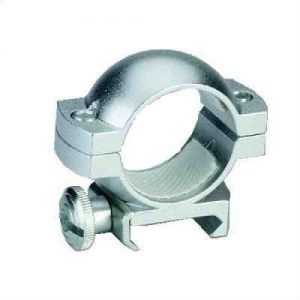
Scope Ring set, Medium, Silver
$7.95Medium, 1 inch scope rings. Matte Silver finish. Weaver style bases.
-
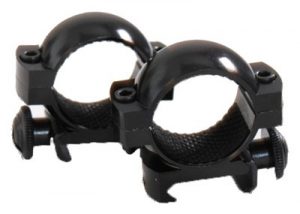
Scope Ring, High, Gloss
$7.95High 1 inch scope rings. Gloss Black finish. Weaver Style
-
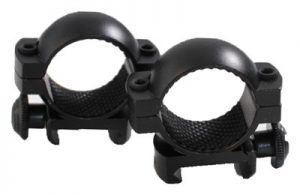
Scope Ring, High, Matte
$7.49High 1 inch scope rings. Matte Black finish. Weaver style bases.
-
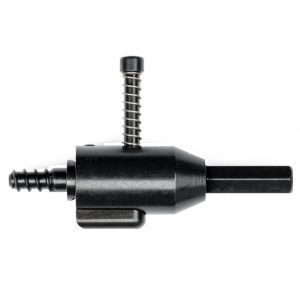
Swivel Studs, custom ball design, Intallation Tool
$21.95The premium choice for installing our custom ball swivel studs. Constructed of heat-treated carbon steel, this tool will not damage stock finish. Hex base designed to fit any standard drill chuck or 1/4-inch nut driver.
(Stud not included)
-
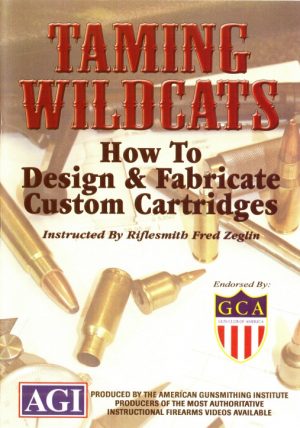
Taming Wildcats, DVD (AGI gunsmithing instruction)
$69.95A wildcat cartridge is a cartridge that is not commercially loaded by a major ammunition manufacturer, but could be loaded by a specialty or contract reloader.
Taming Wildcats: How To Design & Fabricate Custom Cartridges. Is one of AGI’s courses, taught by custom gunsmith Fred Zeglin, renowned cartridge designer and builder of the well-known Hawk series of cartridges, will get the viewer on the road to a thorough understanding of Wildcats and Wildcatting. Great material for any gunsmith or do-it yourself-er who want to make the tools themselves.
One doesn’t need to be a master machinist or tool and die maker to be able to turn out the blank resizing / forming / chamber reamers on the lathe; a tool post grinder is not needed. A bench grinder with a good fine grinding wheel and some practice will, with Zeglin’s expert and easy to follow guidance, will enable the viewer to turn out reamers that will equal anything one can buy! Talk about self reliance.
This video is a valuable addition to your library if you want to know how to design and build custom cartridges, reamers and reloading dies. It provides detailed explanations and demonstrations.
This DVD includes:
Introduction to Wildcat and Wildcatting
The Five Design Steps
Canon Reamers
Resizing Die Reamers
Making a Reamer
Heat Treating a Reamer
Relief Grinding
Sharpening a Reamer
Forming the Brass
Making a Chamber Reamer
Using the Reamer
BONUS – Pages of information on resource material, tools, lubes and more! -
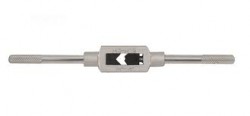
Tap Wrench
$6.00for hand reaming or taps
-
Sale!
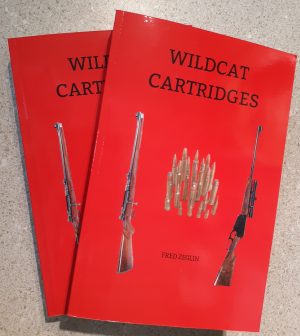
Wildcat Cartridges, Reloader’s Handbook of Wildcat Cartridge Design
Original price was: $49.95.$25.95Current price is: $25.95.In 2005 the hard bound first edition of this handbook hit the market. Since that time it has become a collectable book. This reprint is a faithful reprint of the first edition, now in paperback form.
Fred Zeglin was a gunsmith and custom rifle builder long before he turned to writing. The origin of this book was formed in Fred teaching gunsmiths how to make reamer and reloading dies, as well as how the design and develop a successful wildcat cartridge with tried and true, safe methods.
The last Gunsmith to tackle this subject was P.O. Ackley in the early 1960’s. Fred took inspiration from Ackley’s writings to create a valuable snapshot of the wildcat community since Ackley left the range.
During Zeglin’s years in the gun business he has developed a large number of wildcats, both for his own use and for clients. He made chamber reamers and reloading dies for his customers projects, partly to save time & money, but mostly to deliver product for his clients that they really could not acquire anywhere else.
This manual contains ideas and methods that you will find in no other source. If you are a reloader, wildcatter or gunbug of any sort; you will enjoy and value the history and how-to information found in this book!
574 Pages, 6″x9″, paperback. Signed by the Author

